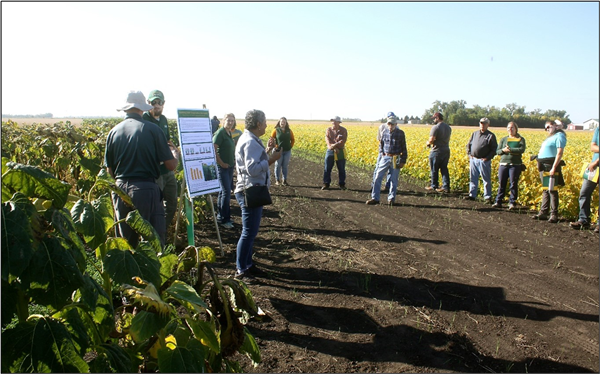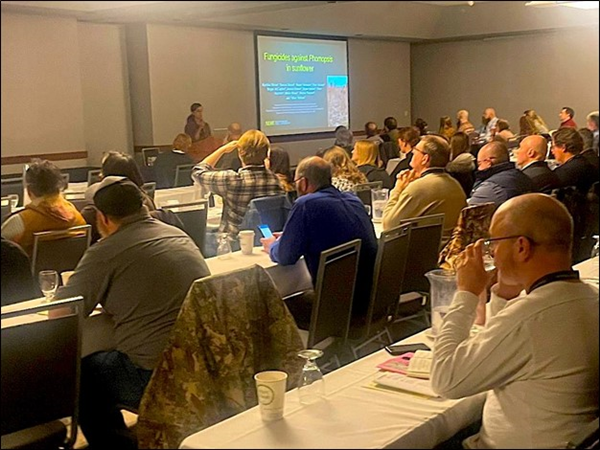
By John Sandbakken*
With lower commodity prices, profit margins have tightened or in some cases evaporated. Everyone is looking for ways to maximize yields to generate as much revenue as possible in order to cash flow. So how do we increase the return per acre?
One way is to have a strong focus on research. Since its inception, the National Sunflower Association (NSA) has committed itself to providing funds to public researchers to find ways to lower production costs, increase quality and obtain higher yields. Agricultural research is critically important in that it is the only way to find avenues to combat new strains of fungi, bacteria, weeds, insects and other pests that can destroy crops. It is also the only way to find new sunflower hybrids which we hope will yield better, be more disease and insect resistant, with better overall trait packages.
“In the past two years it seems like you had to hit a home run on every crop just to break even,” states Josh Greff, NSA vice president and Regent, N.D., producer. “It goes without saying that investing in research that can increase quality and obtain higher yields is critically important to enhancing the bottom line. Improving profitability to sunflower growers and the sunflower industry is the primary goal when the NSA Board of Directors makes research funding decisions.”
How Is NSA Research Funded?
NSA research is mainly funded with checkoff funds from Colorado, Kansas, Minnesota and the Dakotas. To increase the pool of financial resources, the NSA Confection Committee contributes a portion of its funds to research projects. These committee funds come from sunflower industry members not included in the checkoff.
“I have always considered funding research as the most important thing we can do with our checkoff and industry dollars,” says Chuck Todd, NSA president and Onida, S.D., producer. “There is always risk in growing any crop. As an industry, we need to constantly look for ways to mitigate risk and make producing sunflower easier to keep producers interested in the crop.”
How Is Research Prioritized & How Are Projects Chosen?
To help prioritize research areas, the NSA has a research committee made up of researchers, industry leaders and sunflower producers representing all major sunflower states. The committee met in early September to set research priorities for the upcoming year.
After priorities were set, requests for pre-proposals were sent to researchers across the country. Having pre-proposals helps NSA prioritize which proposals moved on to the full proposal phase.
After full proposals are received, the committee will meet in early January to review the submitted proposals; and then each committee member gives each proposal a scientific merit score of 1, 3 or 5, with 5 being the highest. Cost of the proposed research is also given a score using the same method. The two scores are added together and averaged to get a composite score.
“This system seems to be the best method to evaluate and recommend the top research projects to fund in the most impartial way,” says Robert Weigelt, current chairman of the NSA Research Committee. “It allows NSA board members to make prudent funding decisions based on the composite score each proposal receives that takes into account scientific merit and cost.”
Resolving Sclerotinia continues to be a high priority. Grant requests for this disease are directed to the National Sclerotinia Initiative. There is a concentrated research effort in this disease —from wild accessions to fungicide trials and everything in between. NSA is a leader in urging researchers to consider additional or new directions in Sclerotinia sunflower research to find a solution for this disease.
The list below specifies “areas of interest” outlined by the NSA research committee. This is not an exclusive list and the committee will consider all production areas of research.
Research Areas of Interest
(in order of priority)
Production Issues —
The #1 priority for the National Sunflower Association is improved genetic progress in sunflower to enhance competitiveness with other crops and the stability of yield and quality using genomic tools.
Other needs are:
a. More local/regional focused varietal screening, including extension and industry, public and private lines.
b. Blackbirds: Innovative and new approaches to reduce damage, especially discovery of repellents and or changes to plant physical characteristics.
c. Early, mid and later planting date studies are needed to mitigate insects, diseases and crop maturity effects from too early and or too late planting on a state and or regional basis.
Insects —
The #1 priority is red sunflower seed weevil (RSSW) challenges that are inhibiting South Dakota sunflower acreage. The issue is larger than just insecticide resistance and may also include RSSW biology, genetics and seasonal population dispersion. An “All of the Above” approach is needed.
Other needs are:
a. Evaluation of IPM strategies (scouting, trapping, thresholds, insecticide testing [especially new modes of action], cultural, biological) for control of economically important insect pests of sunflower, including red sunflower seed weevil and Dectes stem borer.
Weeds —
The #1 priority is innovative weed control strategies using existing and experimental chemistries to address palmer amaranth, horseweed (marestail), waterhemp and multiple MOA-resistant kochia.
Other needs are:
a. Encourage research for new desiccant active ingredients.
b. Weed species shifts, due to resistance/tolerance to common modes of action need to be considered for burndown uses, as well as existing post systems like Clearfield® and Express®Sun.
c. Define herbicide sunflower safe pre-emerge intervals, even during a drought. Preservation of and MOA resistance management for the post-emerge Group #1 grass products.
d. Group 15 efficacy demonstrations, including improving pigweed, kochia and grass species control, and how layering modes of action used in sunflower can benefit rotation crops such as wheat and corn. Emphasis on timing (late fall versus spring) for layering residual modes of action to lessen over-reliance on spring burndown.
Diseases —
Phomopsis stem canker is the #1 disease priority for the National Sunflower Association. Proposals aimed at studying pathogen biology and improving (or leading to the improvement of) disease management tools.
Other needs are:
a. Rust, including identifying races and the control of rust via genetic resistance and fungicide application.
b. There is continued interest in downy mildew with the development of new races and fungicide efficacy. Proposals looking at genetic resistance along with seed treatments with multiple modes of action will be of interest.
c. Rhizopus can be a concern after the head is damaged by insects, hail or other damage. Determining if there are management or mitigating strategies to reduce the impact of the disease is important for growers.
Product Utilization & Environmental Impacts —
The #1 priority for the National Sunflower Association is quantification of sunflower’s carbon footprint and environmental sustainability, including the renewable diesel industry and carbon sequestration impacts.
Other needs are:
a. Novel compounds in seed that have intrinsic values, including nutrition alternatives and sunflower as a protein source.
 If you would like to hear more about what is happening in sunflower research, considering attending the annual NSA Sunflower Research Forum. The Forum is a popular and well-attended event and will be next held on January 7 and 8, 2026, at the Holiday Inn in Fargo, N.D. The purpose of the Forum is to report on research, to promote discussion, and to stimulate creative thinking. Use this link to get more details: http://www.sunflowernsa.com/events/details.asp?eventID=198
If you would like to hear more about what is happening in sunflower research, considering attending the annual NSA Sunflower Research Forum. The Forum is a popular and well-attended event and will be next held on January 7 and 8, 2026, at the Holiday Inn in Fargo, N.D. The purpose of the Forum is to report on research, to promote discussion, and to stimulate creative thinking. Use this link to get more details: http://www.sunflowernsa.com/events/details.asp?eventID=198
You can also learn more about NSA-funded research projects by going to: http://www.sunflowernsa.com/research/. There you will find an online searchable database of more than 30 years of sunflower research papers.
